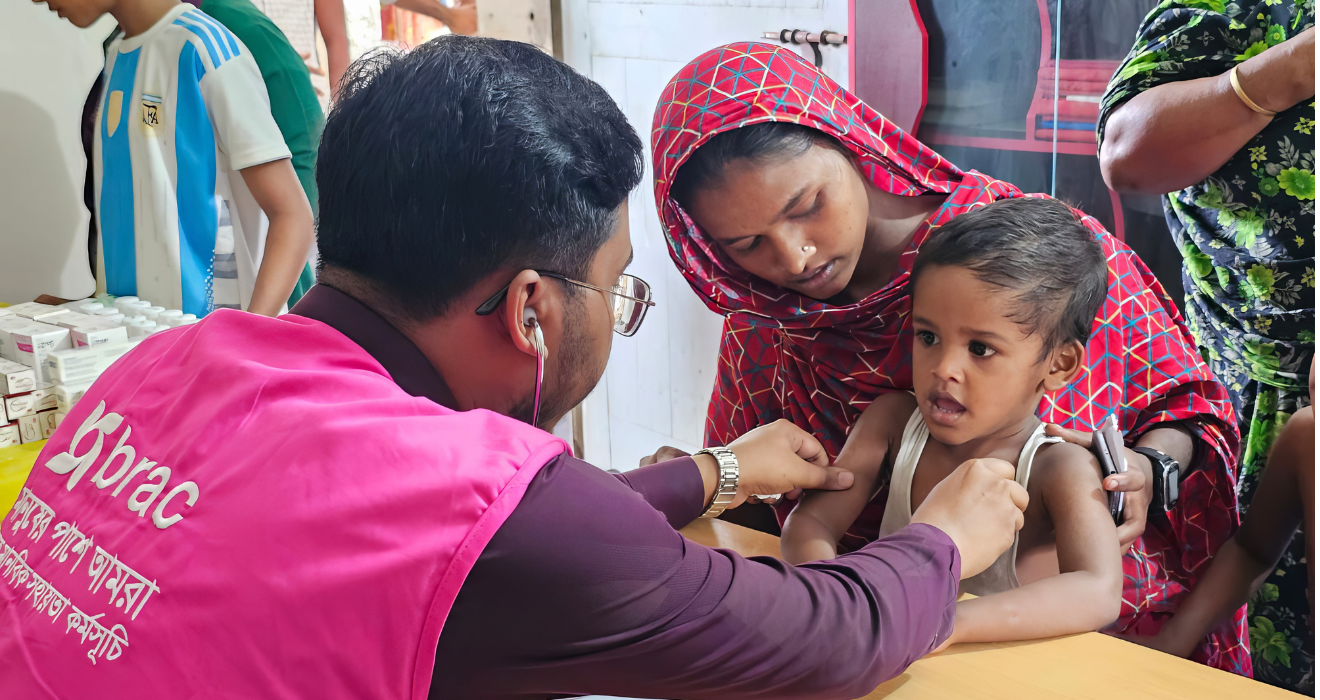Bangladesh floods: One month of action
One month after the worst flooding in three decades, the needs remain great. Discover the latest updates on BRAC’s response.

In Bangladesh, the worst flooding in three decades raced across 11 districts in late August. At the height of the emergency, floodwaters impacted 5.8 million people.
BRAC launched a comprehensive response from the earliest moments of the crisis, with a 5,000-person team of first responders, medical professionals, and technical specialists deployed. Thanks to an outpouring of support, BRAC teams have reached thousands of people.
With donor support, BRAC has already:
✅ established 637 medical camps and delivered care to 115,932 patients
✅ delivered dry food packets to 70,000 families, and distributed 30,000 warm meals
✅ fixed 6,224 water points and disinfected 13,610 tube wells to deliver safe drinking water
✅ provided 181 tons of cattle feed to farmers
✅ and so much more…
On Monday, September 23, BRAC hosted a webinar to provide donors and partners with an update on the teams’ ongoing efforts. The hour-long event featured three individuals helping to steer BRAC’s work. Watch the webinar.
Lives changed in a flash
Khondoker Tawhid, Director of Disaster Risk Management, provided insights into how life changed in a single evening for millions. The people in the affected regions hadn’t experienced a flood of this magnitude in decades. Hampering efforts were major disruptions to the mobile networks, as well as a lack of boats to reach affected areas.
Tawhid shared the powerful testimonies of two women impacted by the flash flood. Karimunnes and Halima, both from Feni, Bangladesh, shared their harrowing stories. “During the crisis, our colleagues met many people like Karimunnes who told us how quickly the water rose, and she had to race through the water to her neighbor’s house,” he said. “Similarly… Halima told us she could not get anything, even food [as she fled].”
The needs in eastern Bangladesh remain acute, and BRAC’s focus has turned to supporting people who experienced major impacts on their ability to work and earn money, their quality of life, and shelter. Tawhid noted how farmers have lost 840,000 acres of crops, some of which remain submerged. Flood damage hit 290 miles of roads, 162,800 water points, 163,488 toilets, and 7,000 schools.
At least 1.8 million people need their homes rebuilt, and another 1.8 million have no access to safe water and sanitation services. Half a million people require health support, and 840,000 people are at risk of malnutrition. Another 1.7 million people have experienced a major impact on their livelihoods. And 700,000 children are out of school.
Tirelessly running medical camps
Dr. Shayla Islam, BRAC’s Associate Director of Health, explained how many health facilities were submerged, and her department needed to scale services for the crisis. Through September 29, BRAC’s health program established 637 medical camps and delivered care for 115,932 patients.
Dr. Islam noted that amid so much stress, many pregnant mothers experienced miscarriages. Patients were also experiencing secondary fungal infections in their hands and feet, injuries, and even cellulitis. Skin infections, like scabies and eczema are prevalent.
“After one week, we started getting waterborne diseases in the camp. Severe cases, people with acute diarrhea and cholera, were referred to health facilities,” Dr. Islam shared. “There were a huge number of snake bites, but fortunately we had the antivenom in our health facilities.”
Driving the car while changing the wheel
Hossain Ishrath Adib, Director of BRAC’s Integrated Development Program and Water, Sanitation and Hygiene Program, stressed that emergencies like this are unfortunately something all regions need to prepare for. He was just back from spending time in eastern Bangladesh, and noted the stark changes he encountered.
“In the last 20 years, I’ve been to this area on so many occasions,” he said. “That part of Bangladesh has been known as historically prosperous, and very much vibrant financially. Bangladesh is no stranger to flooding and natural disasters. But when we talk about flooding, we tend to talk about the northern parts of Bangladesh,” he continued.
“But here, the eastern part of Bangladesh was heavily affected by flooding. It caught not only the communities and population there unguarded, but even us [at BRAC]. It has been so challenging. Given the capacity of BRAC, we are, at times, driving the car while changing the wheel. We are trying our best.”
With 1.8 million people in need of critical wash services, Adib’s teams face a heavy workload over the next four months. WASH teams will disinfect 10,000 water points – reaching 80,000 community members. At schools and health centers, staff will restore WASH services to benefit 64,000 people. They’ll also repair or rebuild 1,000 damaged toilets, and equip 200 educational institutions with hygiene and dignity kits to benefit 90,000 students.
In closing, Adib noted that in this emergency, BRAC has been reminded that even teams that work on non-humanitarian programs, like his own, need to be prepared for more emergencies across Bangladesh.
Support flood victims today
BRAC will continue meeting the urgent and long-term needs of families impacted by the floods for months to come. Donor support will be critical to continue reaching the communities who desperately need access to services, health care, and livelihood support. Give now to support this critical work.
BY MICA BEVINGTON
Mica Bevington is Director of Communications at BRAC.